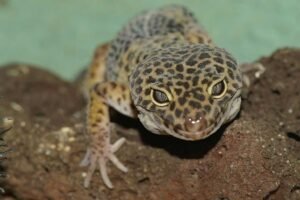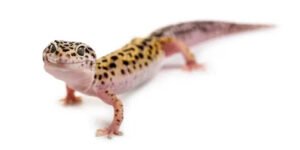how long can leopard geckos go without food?

Healthy adult leopard geckos can go without food for up to two weeks or more, and some have been known to go several months in extreme cases. However, this is not ideal, and they should always have access to clean, fresh drinking water. Leopard geckos can’t survive for very long when dehydrated, so you can mist them lightly once a day to keep them hydrated.
Leopard geckos store fat in their tails and bodies, which allows them to go longer periods of time without eating. If you notice your gecko’s tail becoming drastically thinned and its back bones starting to protrude, you have cause for concern.
There are also other reasons why your leopard gecko might not be eating, including:
Illness or disease
Parasitic infections, impaction, metabolic bone disease (MBD), mouth sores, and abscesses can all cause a loss of appetite. Respiratory infections are also common in reptiles and can cause them to stop eating.
Adjusting to a new enclosure
When geckos are introduced to a new enclosure, they need time to explore and adjust to their new surroundings before they start hunting for food. This process can take around one to two weeks or longer if the enclosure is larger.
Digestion
Leopard geckos require a heat source to properly digest their food. If your gecko is sleeping without a decorative belly heat, it may struggle to digest food and therefore may not be eating.
Typically, otherwise healthy adult Leopard Geckos can survive for about two weeks or even longer without food, and in some extreme situations, they have been reported to last several months without eating, though this is far from optimal. It’s essential that Leopard Geckos always have access to clean, fresh drinking water, as they cannot endure extended periods of dehydration.
Here are two possible reasons you might be inquiring about how long leopard geckos can survive without eating:
- You’re a new leopard gecko owner and you’re curious to know: How often do you need to feed a leopard gecko?
- You’ve been caring for leopard geckos for some time now, but one of them has suddenly stopped eating, and you’re concerned about it. Why is my leopard gecko not eating?
Let’s begin by examining how long leopard geckos can survive without food in order to answer these questions.
How Long Can a Young Leopard Gecko Go Without Eating?
Young leopard geckos can be classified into three categories:
- Infants, also known as “hatchlings” (0–2 months)
- Juveniles (2–6 months)
- Juveniles (6–12 months old)
As you might expect, different ages have unique dietary requirements. For example, the younger the leopard gecko, the more frequently it needs to be fed.
- Baby leopard geckos should be fed every day, but they are also able to go up to 2 days without food.
- It’s preferable for juvenile leopard geckos to eat daily; however, in a pinch, they can go without. up to 7 days without food.
- Sub-adults can go up to 14 days without food assuming they are already well-fed.
When feeding your young leopard geckos, it’s recommended to offer hatchlings insects no larger than ⅜ inches in length, while juveniles should be given insects about ¼ inches long. If the bugs are any larger, your leopard gecko might not eat them.
How Long Can an Adult Leopard Gecko Go Without Eating?
Adult leopard geckos, which are those aged 12 months and older, have different feeding requirements compared to their younger counterparts.
Healthy adult leopard geckos are capable of surviving for up to one month without eating. But wait a moment. This doesn’t mean you can just neglect to feed your leopard gecko for an entire month. It simply implies that if your pet reptile chooses not to eat, you don’t need to worry right away.
You should feed your adult leopard gecko every two to three days. Set a timer for 15–20 minutes and then provide the food. Dubia roaches Crickets or mealworms coated with your preferred seasoning.Calcium and Vitamin D3 supplement”…and allow your leopard gecko to eat as much as it desires.”
Pro Tip: The insects you give to your adult leopard geckos should not be bigger than the distance between their eyes.
If you’re intrigued byBeginning your own Dubia roach colonyTo provide your leopard gecko with some home-cultivated food, check out this informative article to get you started.
Common Reasons Your Leopard Gecko Isn’t Eating
If you observe that your leopard gecko isn’t eating, stay calm. There are various reasons why this might happen, and many of them are not necessarily alarming.
It’s quite common for leopard geckos to cease eating during breeding and ovulation periods. During these times, they have other priorities or one a more significant matter occupying their thoughts at this moment.
Another potential cause for a decreased appetite could be entering into brumation – That period when your gecko is looking for its “winter hibernation.”
And, surprisingly, some leopard geckos can be quite fussy about their food! You may need to try various options with them. Choosing the Right Insects to Feed Your Leopard Gecko When selecting insects to feed your leopard gecko, it is important to consider their nutritional value. Popular options include crickets, mealworms, and dubia roaches.
Crickets are commonly used because they are readily available and easy to digest. Mealworms are another good choice, though they should be fed in moderation due to their high fat content. Dubia roaches are highly nutritious and are often preferred for their protein content. It’s vital to offer a varied diet to ensure your leopard gecko receives a balanced mixture of nutrients.to find those that match its taste.
Other typical appetite suppressants to watch out for include:
- A stressful move Moving into a new home can be stressful for everyone, and leopard geckos are no exception. This stress frequently results in a loss of appetite.
- Tank is too cold Humans tend to become more sluggish during the hot summer months, which often leads to a decreased appetite. Similarly, leopard geckos become lethargic and lose their appetite when temperatures drop. Fortunately, this can be easily remedied by maintaining their habitat temperature between 75°F and 85°F, and keeping their basking area at around 90°F.
- Stress of cohabitation Sharing a living space with others can frequently be stressful, and the same holds true for leopard geckos. The presence of other geckos in their habitat can cause stress, leading to a decrease in appetite. Additionally, male leopard geckos tend to be very aggressive towards each other, often resulting in the death of the weaker male when they are housed together. To prevent such problems, it’s best to keep each leopard gecko in its own separate habitat.
- Disease or illness Sure,Several illnesses can lead to a reduced appetite in leopard geckos, including parasitic infections and impaction. metabolic bone disease (MBD) Even mouth sores and abscesses can cause your leopard gecko to refuse food.
At what stage should you start worrying if your leopard gecko isn’t eating?
Fortunately, their tails and bodies are built to store fat, allowing them to go for fairly long periods without eating. However, if you observe a significant thinning of your leopard gecko’s tail and its back bones becoming visible, it is a matter of concern. You should contact your veterinarian immediately.
Greetings from the Petworled website management, we wish you success and see you in another article on our website.














